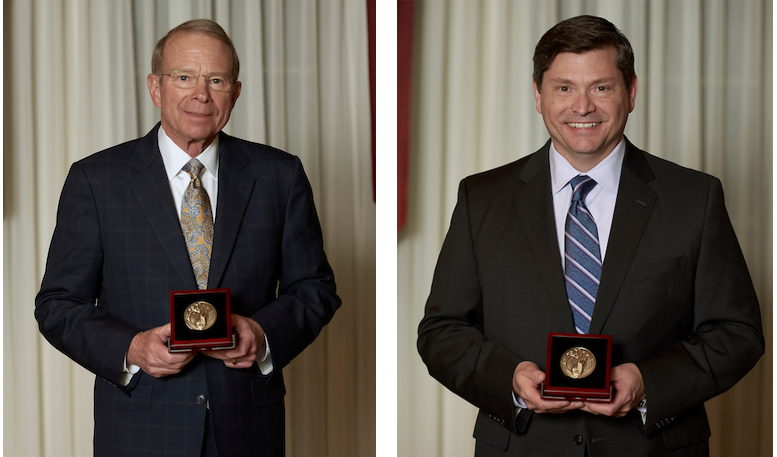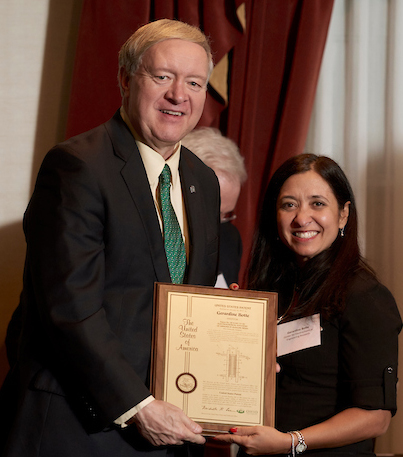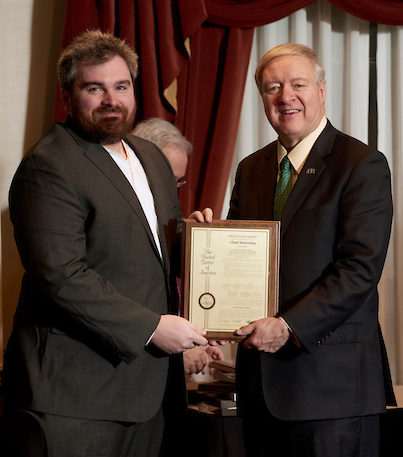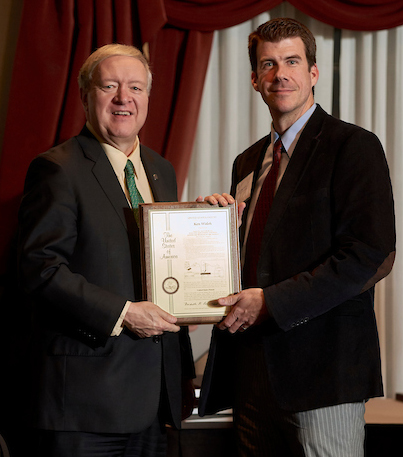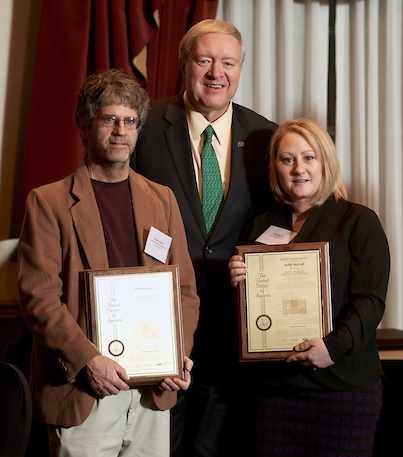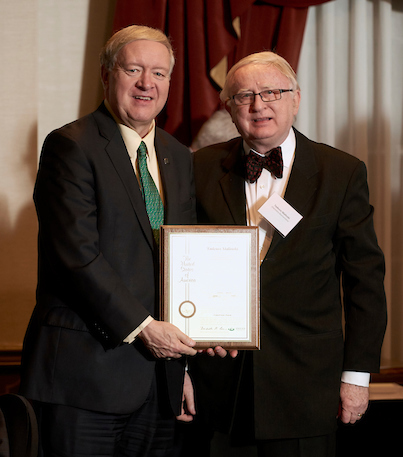Ohio University recognizes the faculty, staff and student inventors of 2017
Ohio University honored faculty, staff and student inventors for discoveries in areas ranging from non-alcoholic fatty liver disease to avionics engineering technologies during an awards ceremony Feb. 7.
The Inventors Dinner recognized individuals who engaged with the university’s Technology Transfer Office over the past year to commercialize their research findings, by protecting their intellectual property through the patent process.
In addition, the 2017 Konneker Medal for Commercialization and Entrepreneurship was awarded to alumni David Pidwell and Rob Painter ( read related story ).
David Pidwell and Rob Painter. Photo credit: Evan Leonard
Ohio University has a successful track record in commercializing technologies. The university ranks first among public Ohio higher education institutions for research licensing revenue, with faculty inventions generating $7.7 million during fiscal year 2016, according to a report from the Association of University Technology Managers (AUTM).
Ohio University received the following U.S. patents for inventions in 2017:
1. “Electrochemical synthesis of ammonia in alkaline media,” Gerardine Botte, Russ College of Engineering and Technology
A method for electrochemically producing ammonia in alkaline media at low temperatures and low pressures. This is a more cost-effective means for manufacturing one of the most highly produced inorganic chemicals worldwide.
President M. Duane Nellis awards Gerardine Botte with a U.S. patent plaque. Photo credit: Evan Leonard.
2. “Reduction of sensor captured data streamed to an operator from an airborne vehicle, allowing the vehicle to carry less equipment,” Chad Mourning, Russ College of Engineering and Technology
A method of reducing the amount of data captured by sensors on a vehicle, streaming the data to an operator, and integrating it into a three-dimensional virtual model created from previously captured target data. The method greatly reduces the bandwidth required to operate an unmanned vehicle.
3. “Wake turbulence analyzer for real-time visualization, detection and avoidance,” Chad Mourning, Russ College of Engineering and Technology
A computer method for determining potential wake turbulence created by an aircraft. A signal is delivered to a following aircraft where a computer generates a wake turbulence boundary, allowing the following aircraft to avoid the potentially dangerous turbulence zone.
President M. Duane Nellis awards Chad Mourning with a U.S. patent plaque. Photo credit: Evan Leonard.
4. “Resetting semi-passive stiffness damper and methods of use thereof,” Kenneth Walsh, Russ College of Engineering and Technology
The patented invention is an improvement on the Semi-Active Resetting Stiffness Damper that allows for comparable control performance with fewer feedback control components. The overall device provides an effective, reliable and inexpensive method for extracting energy from a vibrating body, such as a building experiencing an earthquake.
President M. Duane Nellis awards Ken Walsh with a U.S. patent plaque. Photo credit: Evan Leonard.
5. “Microsecond time-resolved mass spectrometry,” Hao Chen, College of Arts and Sciences
A method for using a mass spectrometer to study the rates at which chemical reactions occur. The method incorporates a liquid sample desorption electrospray ionization mass spectrometry device developed by the Chen lab.
6. “Tight optical integration (TOI) of images with GPS range measurements,” Maarten Uijt de Haag, Russ College of Engineering and Technology
A method of determining the position of a user in 3D space utilizing range measurements from one or more GPS satellites, angular information of a camera located at the user position, and a camera image associated with one or more known markers.
7. “Prevention and Treatment of Non-Alcoholic Fatty Liver Disease,” Kelly McCall and Ramiro Malgor, Heritage College of Osteopathic Medicine; Douglas Goetz, Russ College of Engineering and Technology
This invention is a set of novel compounds designed to treat or reduce the risk of developing non-alcoholic fatty liver disease (NAFLD), a form of fat-induced inflammation of the liver and the leading cause of cirrhosis, chronic liver failure, liver transplantation and primary hepatic cancers in the United States.
President M. Duane Nellis awards Kelly McCall and Douglas Goetz U.S. patent plaques. Photo credit: Evan Leonard.
8. “Systems and Methods for Promoting Wound Healing,” Tadeusz Malinski, College of Arts and Sciences
This invention is a system that provides optimal, efficient and controlled delivery of nitric oxide and carbon monoxide gases, which have been shown to promote accelerated healing. The system would provide tailored delivery rates for nitric oxide and carbon monoxide based on the specific wound type, such as burns, venous ulcers or diabetic foot ulcers, and would not require that the device be in direct physical contact with the damaged skin.
President M. Duane Nellis awards Tadeusz Malinski with a U.S. patent plaque. Photo credit: Evan Leonard.
In addition, Ohio University honored faculty, students and staff who disclosed inventions and for whom the university filed patents. Faculty members who have been named members of the National Academy of Inventors also were recognized.
Invention disclosure is the first step in the technology commercialization process. Technology Transfer Office staff review these disclosures to determine if the intellectual property can be patented and licensed for commercial use. If so, the office files for domestic and foreign patent protection as appropriate, and works with inventors to identify licensing opportunities that can develop the technologies into useful products for the marketplace.
In addition, the Technology Transfer Office works closely with the university’s high-tech business incubator, the Innovation Center, and its state-sponsored Entrepreneurial Services Provider program, TechGROWTH Ohio, to connect inventors to business coaches and sources of seed funding that can help them launch startup companies if appropriate.
For more information about the Ohio University Technology Transfer Office, visit www.ohio.edu/research/tto.
